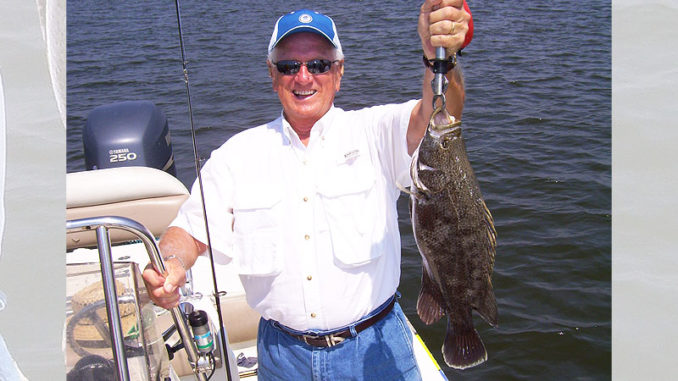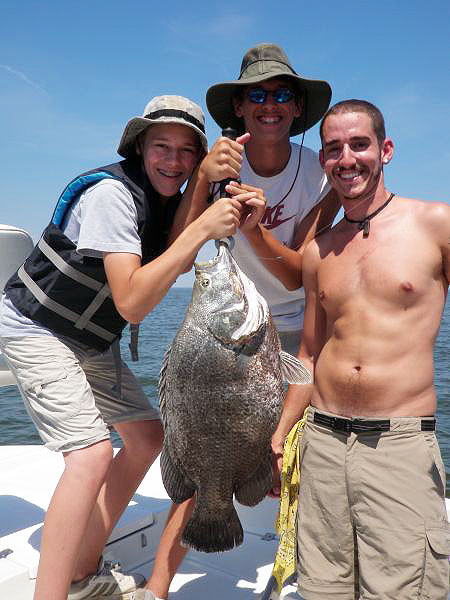
Rodeo winners detail how they target evasive fish and claim there’s one thing you must have to catch them.
There’s a fish worth as many points as a tuna or red snapper in at least one saltwater fishing rodeo along Louisiana’s coast — and arguably as good or better tasting than those two popular species.
The Gulf of Mexico’s tripletail generate plenty of sport and excitement for many offshore anglers, including Lannie Buteau of Jeanerette and Paul Migues of New Iberia.
Buteau, 58, has been fishing offshore since his mid-20s, many of them with the same crew and skipper. He has used each trip as a lesson on how to put fish in the boat.
“Through the years, we’ve learned how to target each species of fish,” he said. “When we first started out, we didn’t have a clue how to target tripletail. It was always a big challenge, even though they can be found outside Southwest Pass (just west of Marsh Island) to 100 miles out.”
One bragging-sized tripletail he hooked and boated, he said, was within sight of Marsh Island.
“I’ve actually caught tripletail by Diamond Reef. One of the biggest tripletail I’ve ever caught I was fishing for redfish by Diamond Reef,” he said.
The man at the helm on the offshore trips they take, for competition or for fun, is Jacques Hebert of Patoutville. Sea Mistress, his 36-foot Lafco hull, has been the top boat at the Iberia Rod & Gun Club Saltwater Fishing Rodeo every year since 2010 and for several years before. Sometimes, a tripletail or two make the difference.
Hebert takes the boat to where the fish are and joins his top-notch crew in putting them in the boat. However, tripletail take a backseat to other species much of the time, he said.
Catching one is a big deal
“We only target tripletail for the rodeo, and it’s a big deal when we catch one,” said Hebert, the 59-year-old owner of Streamline Industries LLC, which provides high-quality machining services and manufacturing of specialized equipment for the oil and gas, sugar and chemical industries.
Migues, 35, who owns Migues Electric LLC, said, “We don’t see a lot of them. When we do see one, especially when we’re fishing a rodeo, you get excited, and you’ve got to put them in the boat. On a good, sunny day, if you’ve covered enough ground, you can pick them up pretty good.”
A floating pallet, he said, is a gold mine for tripletail.
Migues said he’s often thought about going out to target just tripletail, then thought better about it.

“You’re not going to spend a whole day and fuel looking for them. You don’t ride around just to look for a pallet,” he said.
Migues realized, after watching so many saltwater fishing television shows, that other Louisiana anglers target tripletail, and they boat sizeable fish, too, in the 20-pound range.
“Those guys in Venice, to the east, target just tripletail. They go to rigs and, I think, use just live shrimp most of the time,” Migues said. “They found out ways to get them consistently. More people target them there than they do here,” Migues said.
A minimum-size change to 18 inches recently made it more difficult to get tripletail in the ice chest. Buteau said he caught one during last summer’s IR&GC rodeo that was short and had to be released. It was the only one caught on the trip.
Tripletail, with color patterns ranging from shades of yellow brown, to dark brown or black with spots and mottling, have rounded dorsal and anal fins extending almost to the tail. At first glance, the deep-bodied perch-like fish appear to have three tails, which gives them their name.
They are found in most subtropical and tropical waters as well as in coastal waters and murky or muddy estuaries.
Meat is delicious
“Tripletail are a very, very good-eating fish. I put it right up there with grouper. My wife (Elaine) might argue that point,” Buteau said. “Her favorite fish is grouper.”
Buteau’s heaviest tripletail while fishing the Gulf out of Cypremort Point was an 8-pounder many years ago, he said. Migues’ biggest was a 4- or 5-pounder, he said.
“The majority of all tripletail we catch are spotted long before one is hooked. You always need somebody to be on the lookout for debris on the water or a grass line,” Buteau said.

“Paul and I work as a good team finding them and putting in the boat. Paul has an eye in spotting tripletail. It’s hard to spot the debris, the grass line, out in the water,” he said.
The anglers, at least two of them, including someone with a net, fish for them from the front deck of the Sea Mistrees.
“You present the bait a little way out and ease it right up to them, and they’ll leave the debris if they like what they see. Then the biggest challenge is not to get (the fishing line) cut off under the debris or on the grass line,” Buteau said.
And, he said, “They pull weight-for-weight, pound-for-pound, like a tuna.”
Live bait is key
Buteau said he uses a 4/0 hook on 20-pound monofilament line. As for the entrée that might lure the tripletail away from the floating structure, live bait is the key.
“(Live) shrimp (is) one of their favorites,” Buteau said.
Migues said while live shrimp often isn’t available on an offshore trip, live menhaden or small baitfish from the rips will entice strikes from tripletail.
“Being alive and moving around normally triggers tripletail to strike,” he said, noting that putting cut bait on a hook isn’t effective because the fish nibbles all the meat around the hook.
“You have to have some kind of live bait when you pull up on them,” he said.
